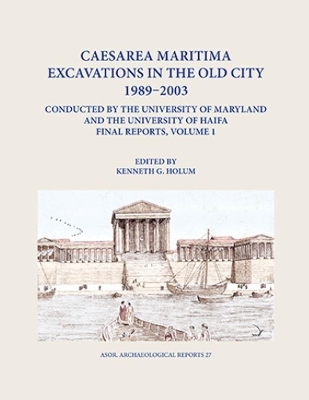
Caesarea Maritima Excavations in the Old City 1989-2003 Final Reports, Volume 1
The Temple Platform, Neighboring Quarters, and the Inner Harbor Quays: Hellenistic Evidence, King Herod's Harbor Temple, Intermediate Occupation, and the Octagonal Harbor Church
Seiten
2021
American Society of Overseas Research (Verlag)
978-0-89757-115-9 (ISBN)
American Society of Overseas Research (Verlag)
978-0-89757-115-9 (ISBN)
This book presents results of the excavation by the Combined Caesarea Expeditions which explored the city and harbour of ancient Caesarea, built by the Jewish king Herod the Great at the end of the first century BCE. It makes a significant contribution to our understanding of the transition from paganism to Christianity in Late Antiquity.
The results of the many years of excavation by the Combined Caesarea Expeditions, a project to explore the city and harbour of ancient Caesarea, built by the Jewish king, Herod the Great, at the end of the first century BCE.
The volume publishes the discoveries on land, both on the Temple Platform (Area TP), built by Herod for his magnificent harbour temple to Roma and Augustus, the neighbouring quarters (Areas TPS and Z), and in the Inner Harbor quays (Area I). Holum presents CCE's original research questions, the overall stratigraphy of the site, and the team's findings about Caesarea from the Hellenistic period to the end of antiquity in the seventh century CE.
In so doing, the book makes a significant contribution to our understanding of the transition from paganism to Christianity in Late Antiquity. It explores in depth King Herod's pagan temple, which existed until about 400 CE, when the now Christian authorities deliberately dismantled it, removing all but its deepest foundations, and let the site lose its holiness. A century later, in 500 CE, the authorities built a grand Octagonal Church in exactly the same spot and on the same alignment as Herod's temple, so that it functioned as a harbour church, visible from far at sea. In the Byzantine period, Caesarea prospered and reached its largest extent.
This book presents the archaeological evidence for these developments, paying careful attention to the foundations of the temple and church, fragments of the superstructure of both monumental buildings, the Herodian and Byzantine staircases that rose directly from the harbour to the temple and church, the pottery, coins, and other evidence, as well as of the vibrant city which surrounded these commanding religious structures.
The results of the many years of excavation by the Combined Caesarea Expeditions, a project to explore the city and harbour of ancient Caesarea, built by the Jewish king, Herod the Great, at the end of the first century BCE.
The volume publishes the discoveries on land, both on the Temple Platform (Area TP), built by Herod for his magnificent harbour temple to Roma and Augustus, the neighbouring quarters (Areas TPS and Z), and in the Inner Harbor quays (Area I). Holum presents CCE's original research questions, the overall stratigraphy of the site, and the team's findings about Caesarea from the Hellenistic period to the end of antiquity in the seventh century CE.
In so doing, the book makes a significant contribution to our understanding of the transition from paganism to Christianity in Late Antiquity. It explores in depth King Herod's pagan temple, which existed until about 400 CE, when the now Christian authorities deliberately dismantled it, removing all but its deepest foundations, and let the site lose its holiness. A century later, in 500 CE, the authorities built a grand Octagonal Church in exactly the same spot and on the same alignment as Herod's temple, so that it functioned as a harbour church, visible from far at sea. In the Byzantine period, Caesarea prospered and reached its largest extent.
This book presents the archaeological evidence for these developments, paying careful attention to the foundations of the temple and church, fragments of the superstructure of both monumental buildings, the Herodian and Byzantine staircases that rose directly from the harbour to the temple and church, the pottery, coins, and other evidence, as well as of the vibrant city which surrounded these commanding religious structures.
| Erscheinungsdatum | 10.05.2021 |
|---|---|
| Reihe/Serie | Archaeological Reports |
| Zusatzinfo | 256 b/w illus, 3 fold-out maps, 13 tbls. |
| Sprache | englisch |
| Maße | 225 x 286 mm |
| Gewicht | 1833 g |
| Themenwelt | Geisteswissenschaften ► Archäologie |
| Geschichte ► Allgemeine Geschichte ► Vor- und Frühgeschichte | |
| Geisteswissenschaften ► Geschichte ► Regional- / Ländergeschichte | |
| ISBN-10 | 0-89757-115-0 / 0897571150 |
| ISBN-13 | 978-0-89757-115-9 / 9780897571159 |
| Zustand | Neuware |
| Haben Sie eine Frage zum Produkt? |
Mehr entdecken
aus dem Bereich
aus dem Bereich
auf den Spuren der frühen Zivilisationen
Buch | Hardcover (2023)
C.H.Beck (Verlag)
CHF 27,95
Konzepte – Methoden – Theorien
Buch | Softcover (2024)
UTB (Verlag)
CHF 55,85
Was Pompeji über uns erzählt
Buch | Hardcover (2023)
Propyläen (Verlag)
CHF 44,75


